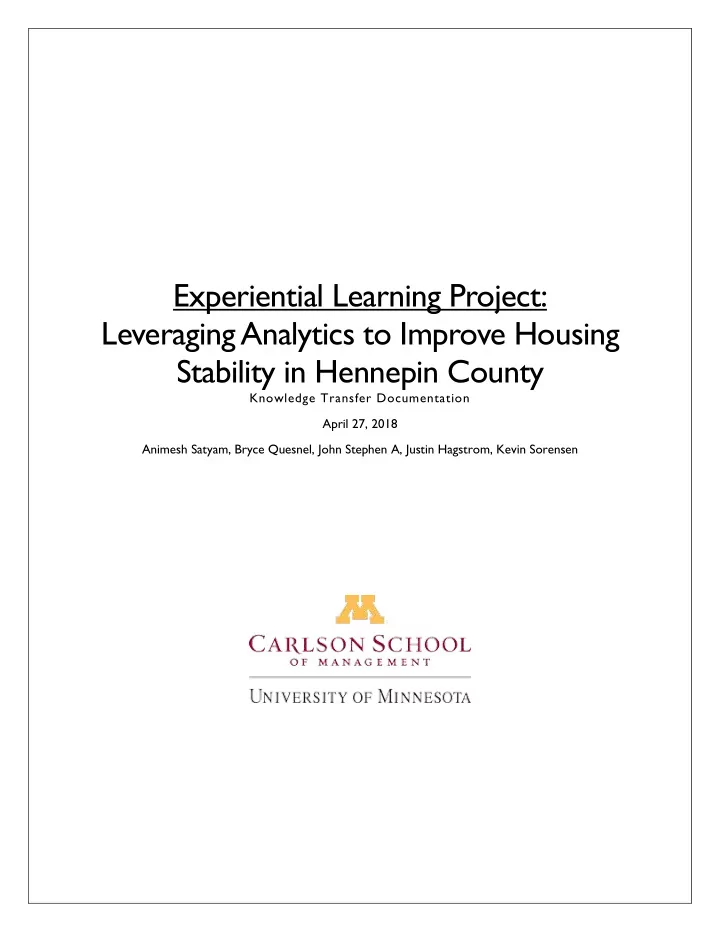

Experiential Learning Project: Leveraging Analytics to Improve Housing Stability in Hennepin County Knowledge Transfer Documentation April 27, 2018 Animesh Satyam, Bryce Quesnel, John Stephen A, Justin Hagstrom, Kevin Sorensen
Contents 1 Overview ............................................................................................................................................... 3 1.1 Description of Project ................................................................................................................... 3 1.2 Question ........................................................................................................................................ 3 1.3 Data ............................................................................................................................................... 3 1.4 Approach ....................................................................................................................................... 4 1.4.1 Predictive Modeling .............................................................................................................. 4 1.4.2 Exploratory Modeling............................................................................................................ 5 1.5 Technical Specifications ................................................................................................................ 5 2 Data Preparation ................................................................................................................................... 7 2.1 Entity Relationship Diagram.......................................................................................................... 7 2.2 Data Aggregation .......................................................................................................................... 7 2.2.1 Choice of Grain ...................................................................................................................... 7 2.2.2 Building our Base File ............................................................................................................ 7 2.3 Candidate Features and Feature Engineering............................................................................... 8 3 Predictive Model Analysis ................................................................................................................... 10 3.1 Algorithm Selection ..................................................................................................................... 10 3.2 Sampling ...................................................................................................................................... 11 3.3 Model Validation ......................................................................................................................... 11 3.3.1 Training, Validation and Testing Datasets .......................................................................... 11 3.3.2 Performance Evaluation ...................................................................................................... 12 3.3.3 Feature Interpretation ........................................................................................................ 13 3.3.4 Feature Usage ..................................................................................................................... 15 3.4 Implementing the model ............................................................................................................ 16 3.4.1 Instructions for using the production model ...................................................................... 16 4 Data Exploration ................................................................................................................................. 19 4.1 Clustering .................................................................................................................................... 19 4.2 Intervention Awareness .............................................................................................................. 21 5 Future Steps ........................................................................................................................................ 24 5.1 Refine models to include landlord and address data ................................................................. 24 5.2 Reduce eviction filings through other strategies ........................................................................ 24 6 References .......................................................................................................................................... 25 7 Appendix ............................................................................................................................................. 26 -1-
7.1 List of Data Tables from Hennepin County ................................................................................. 26 7.2 Feature Importance .................................................................................................................... 28 7.3 Miscellaneous Analysis – Survival Models .................................................................................. 37 7.3.1 Introduction ........................................................................................................................ 37 7.3.2 Model Intuition ................................................................................................................... 38 7.3.3 Preliminary Graphs.............................................................................................................. 39 7.3.4 Model formulation .............................................................................................................. 41 -2-
1 Overview 1.1 Description of Project The purpose of this guide is to act as supportive documentation for the experiential learning project completed in Spring 2018 for Hennepin County as part of the Master of Science in Business Analytics (MSBA) program at the Carlson School of Management. With this guide we hope to pass on the methods, code, and insights that we were able to assemble over the course of the project so that Hennepin County can implement our process well into the future. The models contained herein were presented on May 2, 2018. Should you have further questions about this documentation, please contact: • Bryce Quesnel or John Stephen A for technical questions regarding our predictive model or aspects of feature engineering. • Animesh Satyam, Justin Hagstrom, or Kevin Sorensen for technical questions regarding our exploratory model and general insights. 1.2 Question Hennepin County offers various emergency assistance programs to families and individuals at risk of being evicted from their homes. Unfortunately, the process for an individual or family to receive assistance takes approximately one month to process whereas an eviction can occur within two weeks of someone receiving notification of eviction. Additionally, evictions can end up being more expensive for the county than early housing emergency assistance intervention. It makes financial and ethical sense for the county to proactively anticipate evictions for the clients that they currently serve. Given that eviction filings can happen much more quickly than the process to apply and be approved for emergency assistance, Hennepin County has engaged our team to answer the question: How can Hennepin County anticipate future county client evictions prior to an eviction filing so that the county can intervene by educating county clients about the emergency assistance programs available to county residents? We aim to allow the county to communicate about emergency programs with at-risk county clients with the goal of staving off potential eviction filings. 1.3 Data We received approximately 25 tables each for “control” and “treatment” groups via text file from four separate databases – MAXIS, MMIS, SSIS Shelter System, and HMIS for data spanning 2008 through 2015. The treatment data was intended to be as complete of a dataset, split into 25 tables, for clients on a case which had received an eviction filing that the county could provide. The control data was intended to be a random sample of clients not impacted by an eviction filing. In this way, the county intended to provide us with labeled instances of eviction filings and non-eviction filings; however, we faced a handful of challenges with this approach by the county and these challenges may or may not limit the impact of our conclusions. -3-
Recommend
More recommend